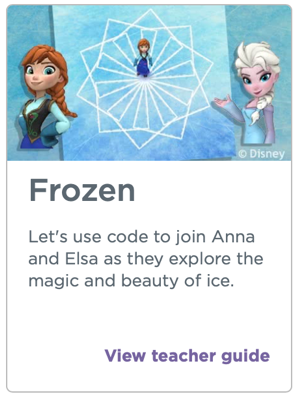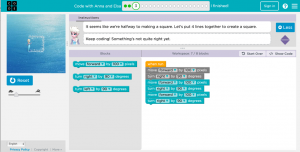‘Flipping’ the classroom at home

Kathy Schofield took a short ‘time out’ from supporting primary science education to spend an hour venturing into computer programming.
 PSTT Regional Mentor Kathy Schofield and her granddaughter explore a simple block-based coding programme, Blockly, though code.org’s free to access ‘Hour of Code’ activity, helping DisneyTM Frozen’s Anna and Elsa to ice skate and make patterns in the ice. During the current lockdown measures, parents should be reassured that they do not need to have all the answers; it may be the case that their children become the teachers and will be able to help them to learn a new skill.
PSTT Regional Mentor Kathy Schofield and her granddaughter explore a simple block-based coding programme, Blockly, though code.org’s free to access ‘Hour of Code’ activity, helping DisneyTM Frozen’s Anna and Elsa to ice skate and make patterns in the ice. During the current lockdown measures, parents should be reassured that they do not need to have all the answers; it may be the case that their children become the teachers and will be able to help them to learn a new skill.
Kathy reports: Having no prior coding skills, I decided to try out a programme I knew would appeal to my grandchildren. I have often wondered why we teach children to code in primary school; now I know why! Children learn better and faster when they’re young. I discovered that they have an easier time learning these skills than I, as an adult, do – their minds are flexible and open, and learning code appears to be like learning a language, far easier when you are young. I was guided in this pursuit by a 9 year old, who processed the programme logically and enjoyed achieving the outcomes. This is an appealing programme for children, perfect for home schooling as the adults can learn alongside the children. The final results can be quite spectacular especially as there are hints and tips along the way to help those of us who are learning a new skill.
 There was ample support whilst working through the coding process. The activity has clear instructions as to what you are aiming to do and how to achieve it. There were helpful hints if the code created is not quite right, giving an opportunity to re-run the code with amendments. Running code alongside the visual representation of what you have created makes it easy to link the instructions created to their outcomes.
There was ample support whilst working through the coding process. The activity has clear instructions as to what you are aiming to do and how to achieve it. There were helpful hints if the code created is not quite right, giving an opportunity to re-run the code with amendments. Running code alongside the visual representation of what you have created makes it easy to link the instructions created to their outcomes.
The trickiest section for both myself and my granddaughter was the move to working with loops; revisiting the video helped us overcome this hurdle. There were no issues with the drag and drop facilities, which were very positive and easy to move around if we got the code wrong.
Looking beyond the learning of code itself, it was apparent that there are a number of transferrable skills that could be transferred to other subjects These skills would be very useful for maths, for example where repeated operations were necessary, and clear links to pattern seeking in science.
The activity is recommended for age 8+. We live in a digital age, and children need to understand how the devices they’re using work and how to control them. This activity introduced coding in a fun way and was pitched at the right level for the age group. Beyond this, a worthwhile thought for teachers, is the experience of genuinely sharing in the learning process. There will undoubtedly be times when children not only take charge of their own learning experience, but also become the teacher, both to their peers and to the person ‘in charge’ of the learning experience.
There are other free ‘Hour of Code’ activities on the code.org site – including Star Wars (for age 6+), Minecraft (6+), and Dance Party (all ages). We have decided to try another coding adventure from the Disney stable and recommended on the Wow Science website, Moana, next, to consolidate our skills with another popular character.
You can find links to these coding activities here:
Code with Anna and Elsa: https://wowscience.co.uk/resource/code-with-anna-and-elsa/http://partners.disney.com/hour-of-code
Hour of Code – Moana: https://wowscience.co.uk/resource/hour-of-code-moana/
Back to blog



 QUICK
QUICK
 MEDIUM
MEDIUM LONG
LONG






